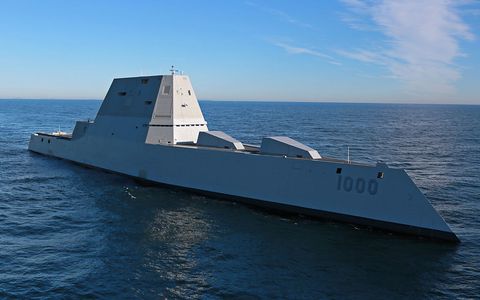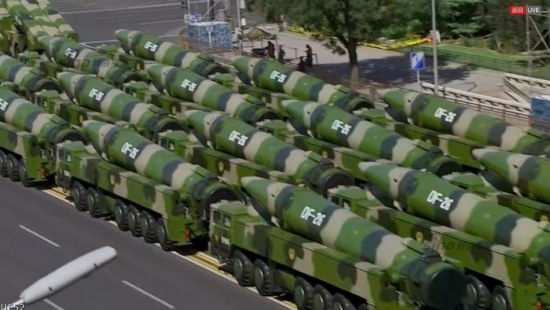- Joined
- Aug 8, 2008
- Messages
- 6,070
- Points
- 83
https://www.popularmechanics.com/mi...s-are-still-shedding-their-rubber-like-skins/
Navy Subs Can't Stop Losing Their Noise-Dampening Skins
Designed to deaden noise, flaps of the rubbery material are falling off at sea.

By Kyle Mizokami
Mar 7, 2017
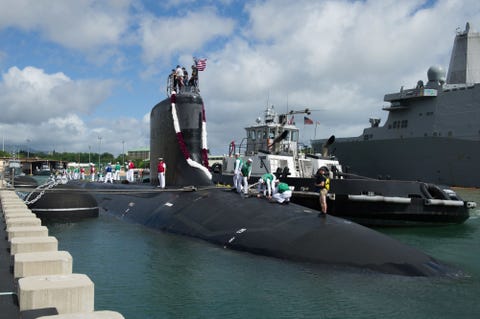
U.S. Navy photo by Mass Communication Specialist 2nd Class Michael H. Lee
The U.S. Navy's Virginia-class submarines are the most advanced submarines in the world. Nuclear-powered and capable of launching cruise missiles and torpedoes, they're formidable underwater opponents. But they still haven't licked one problem: Their rubber coatings are falling off.
Related Videos
This Glider Uses Water-Reactive Fuel to Launch
The Honolulu Star Advertiser has an article about the return of the Virginia-class sub USS Mississippi to its homeport of Pearl Harbor. In the photo accompanying the article, the five year old Mississippi is missing large amounts of the coating, called Special Hull Treatment (SHT), which appears have peeled away while the sub was at sea. The photo is viewable here.
The key to a submarine's survival is evading detection. One way U.S. Navy submarines evade detection is by lowering their noise profile. So-called anechoic coatings consist of rubber tiles that are affixed to the hull with glue, coating as much of it as possible. The rubber tiles break up sound waves that bounce against the hull, reducing the submarine's acoustic signature and making it more difficult to detect via sonar. They also deaden sound emanating from inside the submarine.
The problem, according to naval expert Norman Polmar, is the glue that affixes the tiling to the hull. The glue is exposed to a wide variety of environmental conditions, including big temperature swings as well as the pressures of operating at 1,000 feet beneath the surface. The friction of moving underwater tugs at the coating, and running into objects contributes to it gradually sloughing off.
The SHT problem first surfaced in the civilian world in 2010, when the blog NextNavy brought the issue to light. The Navy has been aware of the issue since 2006 and has been trying to fix it. A 2014 article by the Navy Metalworking Center claimed it had developed an improved process that would go on new submarines starting in 2018, and retrofitted to older subs in 2016. It is not known if Mississippi had received the new coating process.
http://nextnavy.com/the-virginia-peel-why-are-2-billion-dollar-subs-losing-their-skin/
The Virginia Peel: Why are $2 Billion Dollar Subs Losing Their Skin?
by admin on November 7, 2013
AddThis Sharing Buttons
Share to Google Bookmark
Google BookmarkShare to FacebookFacebookShare to TwitterTwitterShare to PrintPrintShare to More
More112
 Submarines rely on stealth. And American Virginia Class submarines are considered the quietest, safest subs on the planet–it’s how the U.S. Navy justifies spending about $2 billion dollars for each of the two boats the nation wants to build every year.
Submarines rely on stealth. And American Virginia Class submarines are considered the quietest, safest subs on the planet–it’s how the U.S. Navy justifies spending about $2 billion dollars for each of the two boats the nation wants to build every year.
So…who would expect that the pricey subs–the foundation of America’s dominance under the seas–would suffer from a congenital skin problem? The Virginia’s sub skin, an innovative, cost-saving Mold-in-Place Special Hull Treatment (MIP/SHT), is failing–and it has been failing for years.
Look, I like the Virginias. The boats are nuclear-powered technological marvels, each capable of launching missiles and raining precision munitions on far-away targets. But we seem to have scrimped a bit on testing and de-bugging the special hull treatment–for those who don’t know, the MIP/SHT is the rubbery-ish insulation that helps the boat evade sonar, stay silent and, ultimately, survive. But the only problem is the hull treatment doesn’t stick to multi-billion-dollar hull. It comes off. In sheets.
I have written about this since late 2010. Here’s USS Texas, back in 2010:

Now, knowing the Virginias are peeling, it is quite funny to watch this week as folks decry the “minor” acoustic penalty imposed by the addition of the capability-enhancing Virginia Payload Module. You see, the Virginia Payload Module introduces a small “hump” in the sub–and the “hump”, by introducing complex currents, can make the ship a little easier to find. Cue hand-wringing, right? I mean it–I know for a fact that some Congressional Appropriators are gonna use this issue to keep the potentially ballistic-missile-ready VPM at bay until they can guarantee funds for a far more expensive–and, I suppose, humpless–SSBN.
Heck, I might even join the chorus of nay-sayers too–that is, if the current boats weren’t already swimming out of their protective coating, returning from a few days–DAYS (!!)–of deployment sporting noise-generating tears (flappers and bangers) and showing bare, active-sonar-loving metal. Some return so tattered that they look like old Soviet subs from the dying days of the Cold War. So, with the SHT/MIP suffering such dramatic failures, what’s a little extra hump-driven hydrodynamic perturbation?
Folks, flappers and bangers make noise. And if we’re going to make a program-delaying issue of the sound generated by the Virginia Payload Module, we darn well had best be treating the noise generated by the “Virginia Peel” in similar fashion. These hull treatment failures may not matter now–as we employ Virginias in Pirate Hunting or other low-risk ISR work, but, in a shooting war, that extra bit of current or loose bit of ripping SHT/MIP could be a matter of life or death.
Even the newest subs are having problems. Here’s the newly-delivered PCU Minnesota in August 2013, a mere two months post-sea trials, sporting her brand-new acoustic penalty:
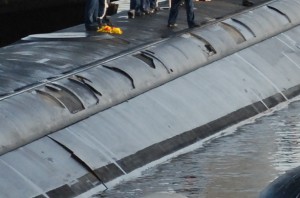
And here’s USS Missouri (SSN 780) leaving port in June of 2013 for a deployment. Notice the rust? And just think about the interesting hydrodynamics going on back there…
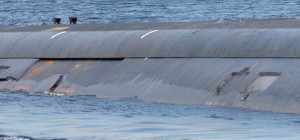
Obviously, we have yet to solve the problem. It’s a known issue. DOT&E wrote about this three years ago. I picked it up, and detailed some of the more dramatic MIP/SHT failures here. The story then got advanced by Peter Frost in a Norfolk paper, where he summed up the issue nicely:
The Virginia Program Office, after getting a bit confused about when they actually identified the issue (either in 2006 or 2007), made soothing noises about how the MIP/SHT failures happened “over a period of years”. I promptly pulled out photos of the then-deployed USS Hawaii, and detailed how a localized MIP/SHT failure evolved into a far larger failure over the course of just a few days. Then Mother Jones went at the story. The Navy went into radio silence, but by early 2011, the Navy was dismissing the matter as solved, with Vice Admiral Kevin McCoy happily holding court in an interview with Peter Frost:
What’s frustrating is that the Minnesota’s Keel was laid a few months after this interview. After, you know, the Navy had “solved” the problem. It suggests that the Navy does not have a good handle on the root cause, or some workers someplace are not being rigorous in controlling the application process. And that is deeply, deeply distressing.
Sure, vets can tell us all about how that, in their day, huge numbers of hull-coating bricks would peel away during a single cruise. But that’s the point. A brick is a single piece–it can be replaced. The MIP/SHT on the Virginias is put into place as a largely unitary system–fixing and replacing it is hard. And expensive. And it puts sailors at risk.
So, if we’re not enduring this embarrassing hull coating failure for some secret squirrel operational reason, let’s apply some energy in fixing it. The Virginias are multi-billion-dollar assets. We’ve had several years to ID the root causes and find a fix. If we don’t have that fix yet, then slow the production line down until we actually have a solution in hand. The reason for doing this is as simple as it gets. On modern battlefields, a noisy sub is a dead sub. And that, dear readers, is unacceptable–a fact that all of us–the Navy, the sub builders and even our divided Congress–can agree on.


https://mil.news.sina.com.cn/jssd/2019-10-10/doc-iicezzrr1173176.shtml
美最大造船厂曝丑闻:静音核潜艇几乎成了海底拖拉机
美最大造船厂曝丑闻:静音核潜艇几乎成了海底拖拉机
710
得益于最完备的水声研究体系、极高的加工精度和秘而不宣的材料学,美国核潜艇在静音性能领域始终“一骑绝尘”,领先世界其它国家不止一个身位。
但令人意想不到的是,近日美国最大军用造船公司亨廷顿-英格尔斯造船厂(HII)爆出的丑闻却显示,由于亨廷顿-英格尔斯内部的偷工减料、伪造合格认证、甚至是对质量管理人员打击报复等怪相横行,美国海军核潜艇的隔离消声瓦根本起不到作用,曾经安静的核潜艇现已和“海底拖拉机”无异。

图为美国海军弗吉尼亚号核潜艇上脱落的消声瓦外层。
具体来说,在美国海军核潜艇壳体外,还另有两层特种橡胶和泡沫塑料构成的隔离消声瓦,它们负责吸收海洋背景和主动声纳的声信号,起到增强潜艇静音性的作用。
由于安装隔离消声瓦的工作需要使用特殊和复杂的有机粘接剂,所以操作这项工作的工人也需要同样专业的培训和认证……但在过去很长一段时间里,亨廷顿-英格尔斯造船厂都放任没有认证的工人去安装隔离消声瓦,这就使得服役后的美国海军核潜艇遭遇了大麻烦。

图为亨廷顿-英格尔斯造船厂的远景,美国海军航母、两栖登陆舰、驱逐舰等装备都在此建造。
如果使用得当,配方复杂的有机粘接剂能够抵消热胀冷缩带来的影响,还能够在深水压、高航速环境下“不放手”,确保隔离消声瓦牢固粘接在艇体上。
但从2010年开始,新近服役的“弗吉尼亚”级核潜艇就频繁受到隔离消声瓦脱落问题的困扰,仅仅六个月的部署就能使得这些新型核潜艇损失数量可观的隔离消声瓦,甚至“半身不遂”。

图为入港的弗吉尼亚级“密西西比”号核潜艇,隔离消声瓦已有普遍脱落。
而从2010年至今,美国海军都一直没有从根本上解决核潜艇的隔离消声瓦脱落问题:对亨廷顿-英格尔斯造船厂的调查不了了之,因为后者伪造了职员认证记录,甚至是隔离消声瓦的合格认证,美国海军只能转向日常使用和维护来寻找原因。
但上梁不正,下梁不可能正。不论美国海军如何地勤勉维护,小心使用,出航跨洋的核潜艇依旧会出现隔离消声瓦脱落的老毛病,甚至“藕断丝连”的情况也不在少数。

图为在亨廷顿-英格尔斯整体建造后下水的“弗吉尼亚”级核潜艇。
至于这一切是如何大白于天下,那还要从一位亨廷顿-英格尔斯工程师对美国政府的告密揭发说起:因为向上级指出潜艇隔离消声瓦的安装存在质量管理问题,这位名叫阿里-劳伦斯的工程师被船厂方面归类到了“安全隐患人员”范畴,手机也被没收整整一个月。
而如排山倒海般的打击报复更是接踵而来:降薪、调职一个不少……至于他所指出的隔离消声瓦安装问题,船厂方面则始终置若罔闻。

图为停有两艘超级航母的亨廷顿-英格尔斯港区。
总的来说,对于存在多年的质量管理问题,亨廷顿-英格尔斯不仅是不闻不问,更是对“指出问题”的员工采取打击报复态度,对可能带来的恶劣后果不屑一顾。
而在如今事发之后,亨廷顿-英格尔斯还依旧能以强大律师团为后盾,声称“我们始终致力于为海军建造最好的军舰,绝不能容忍损害我们向海军交付舰船使命的行为”,其强硬态度可见一斑。
但强硬归强硬,在军工巨头无所畏惧的背后,美国海军核潜艇是否还能在水下同样强硬?树倒猢狲散的道理谁都懂,但实际执行下来往往就不是这么回事了。(作者署名:利刃军事 利刃/TONE)
The biggest shipyard exposure scandal: the silent nuclear submarine is almost a submarine tractor
The biggest shipyard exposure scandal: the silent nuclear submarine is almost a submarine tractor
710
Thanks to the most complete underwater acoustic research system, extremely high processing precision and unspoken material science, the US nuclear submarine has always been “one-of-a-kind” in the field of quiet performance, leading more than one body in other countries in the world.
Unexpectedly, the scandals of the Huntington-Ingles Shipyard (HII), the largest military shipbuilding company in the United States, have shown that the Hunting-Ingles internal cut-off, forgery certification, and even quality The management of the revenge and other grotesque, the isolation of the US Navy nuclear submarine does not play a role, the once quiet nuclear submarine is now the same as the "undersea tractor."
The picture shows the outer layer of the anechoic tile that has fallen off on the US Navy's Virginia nuclear submarine.
Specifically, in addition to the US Navy's nuclear submarine shell, there are two separate layers of special rubber and foam plastic isolation sound-absorbing tiles, which are responsible for absorbing the sound signals of the ocean background and active sonar, and enhancing the quietness of the submarine.
Since the installation of isolated anechoic tiles requires the use of special and complex organic binders, workers who work on this job also need the same professional training and certification... but for a long time, Huntington-Ingle The shipyards have left uncertified workers to install the isolation anechoic tiles, which has caused great trouble for the US Navy nuclear submarines after their service.
The picture shows the vision of the Huntington-Ingles Shipyard, where US Navy aircraft carriers, amphibious landing ships, destroyers and other equipment are built.
If used properly, the complex organic binder can offset the effects of thermal expansion and contraction. It can also “not let go” in deep water pressure and high speed environment, ensuring that the isolated sound-damping tile is firmly bonded to the hull.
However, since 2010, the recently-applied "Virginia"-class nuclear submarines have been plagued by the problem of isolation and anechoic detachment. The deployment of only six months will make these new nuclear submarines lose a considerable amount of isolation and anechoic tiles, even "half-length." ".
The picture shows the Virginia-class "Mississippi" nuclear submarine entering the port, and the isolation anechoic tiles have generally fallen off.
Since 2010, the US Navy has not fundamentally solved the problem of the isolation and elimination of the nuclear submarine. The investigation of the Huntington-Ingles Shipyard has failed because the latter forged the staff certification record, even For the certification of isolated anechoic tiles, the US Navy can only turn to daily use and maintenance to find the cause.
But the upper beam is not right, the lower beam cannot be positive. Regardless of how the US Navy is diligently maintained and carefully used, the nuclear submarines that sail across the ocean will still have the old problems of isolating the anechoic detachment, and even the situation of "smashing the wire" is not rare.
The picture shows the "Virginia" class nuclear submarine launched after Huntington-Ingles was built.
As for how this is all about the world, it is also said from a Huntington-Ingles engineer's whistle-blowing to the US government: because the superior pointed out that the installation of the submarine isolation anechoic tile has quality management problems, the name The engineer named Ali Lawrence was classified by the shipyard as a “safety hazard” and the mobile phone was confiscated for a whole month.
The revenge like the rushing out of the sea is followed by a lot of salary reductions and transfer of duties... As for the installation of the isolation anechoic tile that he pointed out, the shipyard has always turned a deaf ear.
The picture shows the Huntington-Ingles port area with two super carriers.
In general, for many years of quality management issues, Huntington-Ingles is not only ignorant, but also retaliating against the “pointing out” employees, dismissing the possible bad consequences. .
After the incident, Huntington-Ingles can still be backed by a strong lawyers team, claiming that "we are always committed to building the best warships for the Navy, and we must not tolerate damage to our mission to the Navy." ", its tough attitude can be seen.
But the toughness is tough, and behind the military giant's fearlessness, can the US Navy's nuclear submarines be as strong as underwater? Everyone knows the truth of the tree, but it is often not the case when it is actually implemented. (Author's signature: sharp blade military blade / TONE)
Navy Subs Can't Stop Losing Their Noise-Dampening Skins
Designed to deaden noise, flaps of the rubbery material are falling off at sea.

By Kyle Mizokami
Mar 7, 2017

U.S. Navy photo by Mass Communication Specialist 2nd Class Michael H. Lee
The U.S. Navy's Virginia-class submarines are the most advanced submarines in the world. Nuclear-powered and capable of launching cruise missiles and torpedoes, they're formidable underwater opponents. But they still haven't licked one problem: Their rubber coatings are falling off.
Related Videos
This Glider Uses Water-Reactive Fuel to Launch
The Honolulu Star Advertiser has an article about the return of the Virginia-class sub USS Mississippi to its homeport of Pearl Harbor. In the photo accompanying the article, the five year old Mississippi is missing large amounts of the coating, called Special Hull Treatment (SHT), which appears have peeled away while the sub was at sea. The photo is viewable here.
The key to a submarine's survival is evading detection. One way U.S. Navy submarines evade detection is by lowering their noise profile. So-called anechoic coatings consist of rubber tiles that are affixed to the hull with glue, coating as much of it as possible. The rubber tiles break up sound waves that bounce against the hull, reducing the submarine's acoustic signature and making it more difficult to detect via sonar. They also deaden sound emanating from inside the submarine.
The problem, according to naval expert Norman Polmar, is the glue that affixes the tiling to the hull. The glue is exposed to a wide variety of environmental conditions, including big temperature swings as well as the pressures of operating at 1,000 feet beneath the surface. The friction of moving underwater tugs at the coating, and running into objects contributes to it gradually sloughing off.
The SHT problem first surfaced in the civilian world in 2010, when the blog NextNavy brought the issue to light. The Navy has been aware of the issue since 2006 and has been trying to fix it. A 2014 article by the Navy Metalworking Center claimed it had developed an improved process that would go on new submarines starting in 2018, and retrofitted to older subs in 2016. It is not known if Mississippi had received the new coating process.
http://nextnavy.com/the-virginia-peel-why-are-2-billion-dollar-subs-losing-their-skin/
The Virginia Peel: Why are $2 Billion Dollar Subs Losing Their Skin?
by admin on November 7, 2013
AddThis Sharing Buttons
Share to Google Bookmark
Google BookmarkShare to FacebookFacebookShare to TwitterTwitterShare to PrintPrintShare to More
More112
 Submarines rely on stealth. And American Virginia Class submarines are considered the quietest, safest subs on the planet–it’s how the U.S. Navy justifies spending about $2 billion dollars for each of the two boats the nation wants to build every year.
Submarines rely on stealth. And American Virginia Class submarines are considered the quietest, safest subs on the planet–it’s how the U.S. Navy justifies spending about $2 billion dollars for each of the two boats the nation wants to build every year.So…who would expect that the pricey subs–the foundation of America’s dominance under the seas–would suffer from a congenital skin problem? The Virginia’s sub skin, an innovative, cost-saving Mold-in-Place Special Hull Treatment (MIP/SHT), is failing–and it has been failing for years.
Look, I like the Virginias. The boats are nuclear-powered technological marvels, each capable of launching missiles and raining precision munitions on far-away targets. But we seem to have scrimped a bit on testing and de-bugging the special hull treatment–for those who don’t know, the MIP/SHT is the rubbery-ish insulation that helps the boat evade sonar, stay silent and, ultimately, survive. But the only problem is the hull treatment doesn’t stick to multi-billion-dollar hull. It comes off. In sheets.
I have written about this since late 2010. Here’s USS Texas, back in 2010:

Now, knowing the Virginias are peeling, it is quite funny to watch this week as folks decry the “minor” acoustic penalty imposed by the addition of the capability-enhancing Virginia Payload Module. You see, the Virginia Payload Module introduces a small “hump” in the sub–and the “hump”, by introducing complex currents, can make the ship a little easier to find. Cue hand-wringing, right? I mean it–I know for a fact that some Congressional Appropriators are gonna use this issue to keep the potentially ballistic-missile-ready VPM at bay until they can guarantee funds for a far more expensive–and, I suppose, humpless–SSBN.
Heck, I might even join the chorus of nay-sayers too–that is, if the current boats weren’t already swimming out of their protective coating, returning from a few days–DAYS (!!)–of deployment sporting noise-generating tears (flappers and bangers) and showing bare, active-sonar-loving metal. Some return so tattered that they look like old Soviet subs from the dying days of the Cold War. So, with the SHT/MIP suffering such dramatic failures, what’s a little extra hump-driven hydrodynamic perturbation?
Folks, flappers and bangers make noise. And if we’re going to make a program-delaying issue of the sound generated by the Virginia Payload Module, we darn well had best be treating the noise generated by the “Virginia Peel” in similar fashion. These hull treatment failures may not matter now–as we employ Virginias in Pirate Hunting or other low-risk ISR work, but, in a shooting war, that extra bit of current or loose bit of ripping SHT/MIP could be a matter of life or death.
Even the newest subs are having problems. Here’s the newly-delivered PCU Minnesota in August 2013, a mere two months post-sea trials, sporting her brand-new acoustic penalty:

And here’s USS Missouri (SSN 780) leaving port in June of 2013 for a deployment. Notice the rust? And just think about the interesting hydrodynamics going on back there…

Obviously, we have yet to solve the problem. It’s a known issue. DOT&E wrote about this three years ago. I picked it up, and detailed some of the more dramatic MIP/SHT failures here. The story then got advanced by Peter Frost in a Norfolk paper, where he summed up the issue nicely:
The specialized hull coating is designed to be “anechoic,” or able to absorb waves of active sonar so it does not bounce back to the ship or sub emitting the signal. It’s a crucial component to the stealth of the so-called “silent service,” making the sub more difficult to detect by adversaries.
Missing coating could diminish that effect, but the larger concern is the sound water makes as it flows over an uneven surface, said Norman Polmar, a naval analyst and author who has written about submarines.
“When pieces of the hull coating fall off, the sub gets noisier because it interrupts the water flow over the hull,” Polmar said. “When you put more noise in the water, you’re easier to detect.”
The Virginia Program Office, after getting a bit confused about when they actually identified the issue (either in 2006 or 2007), made soothing noises about how the MIP/SHT failures happened “over a period of years”. I promptly pulled out photos of the then-deployed USS Hawaii, and detailed how a localized MIP/SHT failure evolved into a far larger failure over the course of just a few days. Then Mother Jones went at the story. The Navy went into radio silence, but by early 2011, the Navy was dismissing the matter as solved, with Vice Admiral Kevin McCoy happily holding court in an interview with Peter Frost:
“Clearly we had problems on the early ships,” said Vice Adm. Kevin M. McCoy, commander of Naval Sea Systems Command, the Navy’s ship-buying and maintenance arm. “We think, for the most part, those issues are behind us.”
The loss of the specialized hull coating — designed to be “anechoic,” or able to absorb waves of active sonar so it does not bounce back to the ship or sub emitting the signal — could imperil underway submarines by making them easier to detect.
Despite those problems, McCoy insisted that the hull-coating failures have not contributed to operational issues for the submarines, saying “It’s not been a real big deal for us.”
McCoy said the Navy’s investigation revealed “no single smoking gun,” and that he’s “very confident going forward” that the Navy’s fast-attack submarines will retain the thick black coating that helps keep them silent and stealthy.
Affected submarines are being fixed during their normal dry-dock maintenance periods.
What’s frustrating is that the Minnesota’s Keel was laid a few months after this interview. After, you know, the Navy had “solved” the problem. It suggests that the Navy does not have a good handle on the root cause, or some workers someplace are not being rigorous in controlling the application process. And that is deeply, deeply distressing.
Sure, vets can tell us all about how that, in their day, huge numbers of hull-coating bricks would peel away during a single cruise. But that’s the point. A brick is a single piece–it can be replaced. The MIP/SHT on the Virginias is put into place as a largely unitary system–fixing and replacing it is hard. And expensive. And it puts sailors at risk.
So, if we’re not enduring this embarrassing hull coating failure for some secret squirrel operational reason, let’s apply some energy in fixing it. The Virginias are multi-billion-dollar assets. We’ve had several years to ID the root causes and find a fix. If we don’t have that fix yet, then slow the production line down until we actually have a solution in hand. The reason for doing this is as simple as it gets. On modern battlefields, a noisy sub is a dead sub. And that, dear readers, is unacceptable–a fact that all of us–the Navy, the sub builders and even our divided Congress–can agree on.


https://mil.news.sina.com.cn/jssd/2019-10-10/doc-iicezzrr1173176.shtml
美最大造船厂曝丑闻:静音核潜艇几乎成了海底拖拉机
美最大造船厂曝丑闻:静音核潜艇几乎成了海底拖拉机
710
得益于最完备的水声研究体系、极高的加工精度和秘而不宣的材料学,美国核潜艇在静音性能领域始终“一骑绝尘”,领先世界其它国家不止一个身位。
但令人意想不到的是,近日美国最大军用造船公司亨廷顿-英格尔斯造船厂(HII)爆出的丑闻却显示,由于亨廷顿-英格尔斯内部的偷工减料、伪造合格认证、甚至是对质量管理人员打击报复等怪相横行,美国海军核潜艇的隔离消声瓦根本起不到作用,曾经安静的核潜艇现已和“海底拖拉机”无异。

图为美国海军弗吉尼亚号核潜艇上脱落的消声瓦外层。
具体来说,在美国海军核潜艇壳体外,还另有两层特种橡胶和泡沫塑料构成的隔离消声瓦,它们负责吸收海洋背景和主动声纳的声信号,起到增强潜艇静音性的作用。
由于安装隔离消声瓦的工作需要使用特殊和复杂的有机粘接剂,所以操作这项工作的工人也需要同样专业的培训和认证……但在过去很长一段时间里,亨廷顿-英格尔斯造船厂都放任没有认证的工人去安装隔离消声瓦,这就使得服役后的美国海军核潜艇遭遇了大麻烦。

图为亨廷顿-英格尔斯造船厂的远景,美国海军航母、两栖登陆舰、驱逐舰等装备都在此建造。
如果使用得当,配方复杂的有机粘接剂能够抵消热胀冷缩带来的影响,还能够在深水压、高航速环境下“不放手”,确保隔离消声瓦牢固粘接在艇体上。
但从2010年开始,新近服役的“弗吉尼亚”级核潜艇就频繁受到隔离消声瓦脱落问题的困扰,仅仅六个月的部署就能使得这些新型核潜艇损失数量可观的隔离消声瓦,甚至“半身不遂”。

图为入港的弗吉尼亚级“密西西比”号核潜艇,隔离消声瓦已有普遍脱落。
而从2010年至今,美国海军都一直没有从根本上解决核潜艇的隔离消声瓦脱落问题:对亨廷顿-英格尔斯造船厂的调查不了了之,因为后者伪造了职员认证记录,甚至是隔离消声瓦的合格认证,美国海军只能转向日常使用和维护来寻找原因。
但上梁不正,下梁不可能正。不论美国海军如何地勤勉维护,小心使用,出航跨洋的核潜艇依旧会出现隔离消声瓦脱落的老毛病,甚至“藕断丝连”的情况也不在少数。

图为在亨廷顿-英格尔斯整体建造后下水的“弗吉尼亚”级核潜艇。
至于这一切是如何大白于天下,那还要从一位亨廷顿-英格尔斯工程师对美国政府的告密揭发说起:因为向上级指出潜艇隔离消声瓦的安装存在质量管理问题,这位名叫阿里-劳伦斯的工程师被船厂方面归类到了“安全隐患人员”范畴,手机也被没收整整一个月。
而如排山倒海般的打击报复更是接踵而来:降薪、调职一个不少……至于他所指出的隔离消声瓦安装问题,船厂方面则始终置若罔闻。

图为停有两艘超级航母的亨廷顿-英格尔斯港区。
总的来说,对于存在多年的质量管理问题,亨廷顿-英格尔斯不仅是不闻不问,更是对“指出问题”的员工采取打击报复态度,对可能带来的恶劣后果不屑一顾。
而在如今事发之后,亨廷顿-英格尔斯还依旧能以强大律师团为后盾,声称“我们始终致力于为海军建造最好的军舰,绝不能容忍损害我们向海军交付舰船使命的行为”,其强硬态度可见一斑。
但强硬归强硬,在军工巨头无所畏惧的背后,美国海军核潜艇是否还能在水下同样强硬?树倒猢狲散的道理谁都懂,但实际执行下来往往就不是这么回事了。(作者署名:利刃军事 利刃/TONE)
The biggest shipyard exposure scandal: the silent nuclear submarine is almost a submarine tractor
The biggest shipyard exposure scandal: the silent nuclear submarine is almost a submarine tractor
710
Thanks to the most complete underwater acoustic research system, extremely high processing precision and unspoken material science, the US nuclear submarine has always been “one-of-a-kind” in the field of quiet performance, leading more than one body in other countries in the world.
Unexpectedly, the scandals of the Huntington-Ingles Shipyard (HII), the largest military shipbuilding company in the United States, have shown that the Hunting-Ingles internal cut-off, forgery certification, and even quality The management of the revenge and other grotesque, the isolation of the US Navy nuclear submarine does not play a role, the once quiet nuclear submarine is now the same as the "undersea tractor."
The picture shows the outer layer of the anechoic tile that has fallen off on the US Navy's Virginia nuclear submarine.
Specifically, in addition to the US Navy's nuclear submarine shell, there are two separate layers of special rubber and foam plastic isolation sound-absorbing tiles, which are responsible for absorbing the sound signals of the ocean background and active sonar, and enhancing the quietness of the submarine.
Since the installation of isolated anechoic tiles requires the use of special and complex organic binders, workers who work on this job also need the same professional training and certification... but for a long time, Huntington-Ingle The shipyards have left uncertified workers to install the isolation anechoic tiles, which has caused great trouble for the US Navy nuclear submarines after their service.
The picture shows the vision of the Huntington-Ingles Shipyard, where US Navy aircraft carriers, amphibious landing ships, destroyers and other equipment are built.
If used properly, the complex organic binder can offset the effects of thermal expansion and contraction. It can also “not let go” in deep water pressure and high speed environment, ensuring that the isolated sound-damping tile is firmly bonded to the hull.
However, since 2010, the recently-applied "Virginia"-class nuclear submarines have been plagued by the problem of isolation and anechoic detachment. The deployment of only six months will make these new nuclear submarines lose a considerable amount of isolation and anechoic tiles, even "half-length." ".
The picture shows the Virginia-class "Mississippi" nuclear submarine entering the port, and the isolation anechoic tiles have generally fallen off.
Since 2010, the US Navy has not fundamentally solved the problem of the isolation and elimination of the nuclear submarine. The investigation of the Huntington-Ingles Shipyard has failed because the latter forged the staff certification record, even For the certification of isolated anechoic tiles, the US Navy can only turn to daily use and maintenance to find the cause.
But the upper beam is not right, the lower beam cannot be positive. Regardless of how the US Navy is diligently maintained and carefully used, the nuclear submarines that sail across the ocean will still have the old problems of isolating the anechoic detachment, and even the situation of "smashing the wire" is not rare.
The picture shows the "Virginia" class nuclear submarine launched after Huntington-Ingles was built.
As for how this is all about the world, it is also said from a Huntington-Ingles engineer's whistle-blowing to the US government: because the superior pointed out that the installation of the submarine isolation anechoic tile has quality management problems, the name The engineer named Ali Lawrence was classified by the shipyard as a “safety hazard” and the mobile phone was confiscated for a whole month.
The revenge like the rushing out of the sea is followed by a lot of salary reductions and transfer of duties... As for the installation of the isolation anechoic tile that he pointed out, the shipyard has always turned a deaf ear.
The picture shows the Huntington-Ingles port area with two super carriers.
In general, for many years of quality management issues, Huntington-Ingles is not only ignorant, but also retaliating against the “pointing out” employees, dismissing the possible bad consequences. .
After the incident, Huntington-Ingles can still be backed by a strong lawyers team, claiming that "we are always committed to building the best warships for the Navy, and we must not tolerate damage to our mission to the Navy." ", its tough attitude can be seen.
But the toughness is tough, and behind the military giant's fearlessness, can the US Navy's nuclear submarines be as strong as underwater? Everyone knows the truth of the tree, but it is often not the case when it is actually implemented. (Author's signature: sharp blade military blade / TONE)

